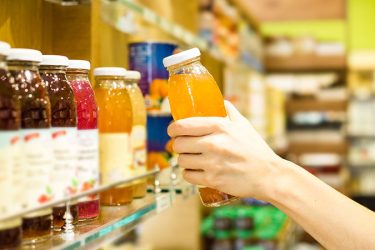Reigniting the magic in better-for-you drinks
- Like
- Digg
- Del
- Tumblr
- VKontakte
- Buffer
- Love This
- Odnoklassniki
- Meneame
- Blogger
- Amazon
- Yahoo Mail
- Gmail
- AOL
- Newsvine
- HackerNews
- Evernote
- MySpace
- Mail.ru
- Viadeo
- Line
- Comments
- Yummly
- SMS
- Viber
- Telegram
- Subscribe
- Skype
- Facebook Messenger
- Kakao
- LiveJournal
- Yammer
- Edgar
- Fintel
- Mix
- Instapaper
- Copy Link
Posted: 1 November 2022 | IFF | No comments yet
From sugar reduction to taste modulation – IFF reflects on the benefits of taking an holistic approach to today’s beverage trends.


Most of us love it, but fewer of us want it. Sugar in beverages is increasingly regulated all over the world and manufacturers are feeling the squeeze – not only from the growing number of national sugar taxes, but from consumers demanding a wide range of healthier, yet delicious choices.
Although it has been several decades since the first sugar-reduced beverages arrived on the market, the struggle for uncompromised taste remains. It all points to a clear need for a new approach.
Evolution of a challenge
For many manufacturers, the story of sugar replacement has been a long evolutionary process that began with high-intensity sweeteners and then moved on to natural sweeteners—such as stevia, with its liquorice after-taste and bitter off-note.
Today, many are focusing on simply driving down the sugar content in low-sugar formulations and using flavourings to make up the shortfall in sweetness.
According to Euromonitor, the global sugar-reduced beverage category grew a significant five percent year-on-year over the past five years. The challenges have only become more complex with the rise of better-for-you categories, such as functional beverages, which have added active ingredients like vitamins, botanicals and probiotics.
Low sugar by default
“Sugar reduction is an old-fashioned term,” said Midey González, Global Innovation Modulation Director for IFF‘s Nourish division. “Right now, consumers are looking for healthy products which are low in sugar by default.
“The challenge that many manufacturers struggle with is that taste is not the only issue with many sweeteners. If you are also trying to add active ingredients to make your beverages healthier, then about 80 percent of these ingredients have off-notes that bring the taste out of balance.”
The issue, in a nutshell, is how to make better-for-you beverages taste good while staying true to the promise of a healthier product.
“From a technical point of view, it requires us to be more creative. Sugar is, after all, a magic ingredient that doesn’t just deliver sweetness. It greatly impacts the whole taste, texture, mouthfeel and visual appeal. So, you can’t just replace it with a sweetener and a bulking agent,” González concluded.
It’s for precisely this reason that a holistic approach to product design is the key to success. By focusing on modulating the whole recipe, taste and texture can be optimised to differentiate a product.
Global market drivers
Global market trends point to multiple reasons why a holistic approach to beverage design is likely to give manufacturers a competitive edge. According to IFF’s Human and Consumer tracker 2021 study, 94 percent of consumers act to improve their wellbeing – a clear indication that consumers are taking greater ownership of their health.
In Latin America, Africa and Asia, for example, the sugar moderation and avoidance trends have gathered pace through the COVID-19 pandemic, starting with a sharper public focus on body weight management and immune health.1


Manufacturers need a creative toolbox to support beverage reformulation and new product development – creating healthier, tastier beverages that will keep consumers coming back for more
Asia showed a significant rise in annual product launches in no/low/reduced-sugar and calorie claims in beverages over the past five years.2 Similarly, in Africa, close to 1,000 beverages launched between 2017 and 2022 had a low or no sugar added claim.3 This trend is spreading from the continent’s south to the east and west.
Add that to GlobalData’s survey of 10 Asia Pacific markets, where sugar-sweetened beverages are a key source of dietary sugar: here, four in every five consumers said they were taking active steps to cut their sugar consumption.4
Among all European countries, the UK stands out for the highest share of ‘no added sugar’ claims on food and drink launches – a response to rising consumer health awareness.5
However, manufacturers should note UK consumers’ wariness towards using artificial sweeteners. Although plant-based sweeteners such as stevia are widely considered a preferable natural alternative, many consumers are put off by the negative impact on taste. Put these global trends together with the fact that more than 50 countries have imposed taxes on sugar-sweetened beverages, and the motivation for holistic product design is understandably high.
The core of the challenge
At IFF, Kees Wisse, Global Innovation Director for Beverages & Hydrocolloids, splits the challenge into two primary issues. The first is taste – providing the upfront sugar-like profile and flavour enhancement while avoiding bitterness and other off-notes. The second is filling the gap when sugar is taken out; securing a syrupy body and texture, excellent visual appeal, and flavour release and stability throughout shelf life.
“In short, manufacturers need a creative toolbox to support beverage reformulation and new product development – creating healthier, tastier beverages that will keep consumers coming back for more,” explained Wisse.
For a flavours, food design and ingredients company like IFF that has long worked with sugar reduction, there is decades of experience to draw on. This knowledge has formed the basis for developing new technologies that can give the coming generation of better-for-you beverages the healthy, indulgent qualities that consumers seek.
Inspiring innovation
IFF has developed a series of healthy beverage concepts to highlight the possibilities of meeting a range of consumer needs with today’s ingredient technology.
“Today’s ingredient technology gives beverage manufacturers almost endless possibilities to develop new products that precisely match consumer needs and expectations. To stay competitive, beverage formulators must provide better-for-you solutions which meet consumer demands and address government sugar mandates,” Wisse concludes.
In other words, sugar reduction is no longer an excuse for poor taste and texture. The sky is the limit for those who master the art of taste modulation.
References
- Mintel GNPD
- Mintel GNPD
- Mintel GNPD
- GlobalData 2021
- www.mintel.com/press-centre/food-and-drink/mintel-expects-fibre-and-next-generation-stevia-to-shake-up-sugar-reduction
About the authors
Kees Wisse is currently the Global Innovation Director for Beverages & Hydrocolloids in IFF. A Food Technologist by training and more than 17 years in IFF, Kees has been instrumental in the creation and design of beverages and dairy for Europe and Africa, Middle East and India. With vast experience in ingredients for juices and juice drinks, he is passionate about the evolution of flavor solutions for sugar or calorie reduced beverages to create better-for-you beverages that consumers crave.
González Midey is currently the Global Innovation Director for Modulation under IFF’s RE-IMAGINE WELLNESS ™ innovation programme. Globally across categories, González supports the innovation work for healthier and tasty food with less sugar and less salt.
She has more than 20 years’ experience in food and food ingredients with special focus and passion for designing caloric and non-caloric sweeteners, bulking systems and flavor modulation.
Midey has a specialisation in physicochemical and functionality of food ingredients and an MBA in Strategy Marketing.
Related topics
Health & Nutrition, Ingredients, New product development (NPD), Product Development, Research & development, Technology & Innovation
Related organisations
Related regions
Africa, Asia Pacific & Oceania, Central and South America, Europe, North America, UK & Ireland









